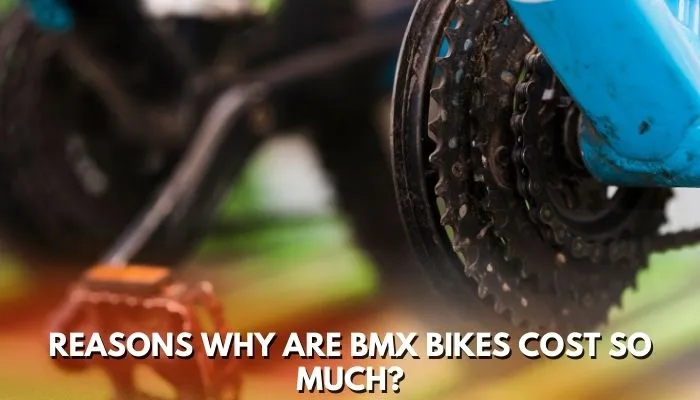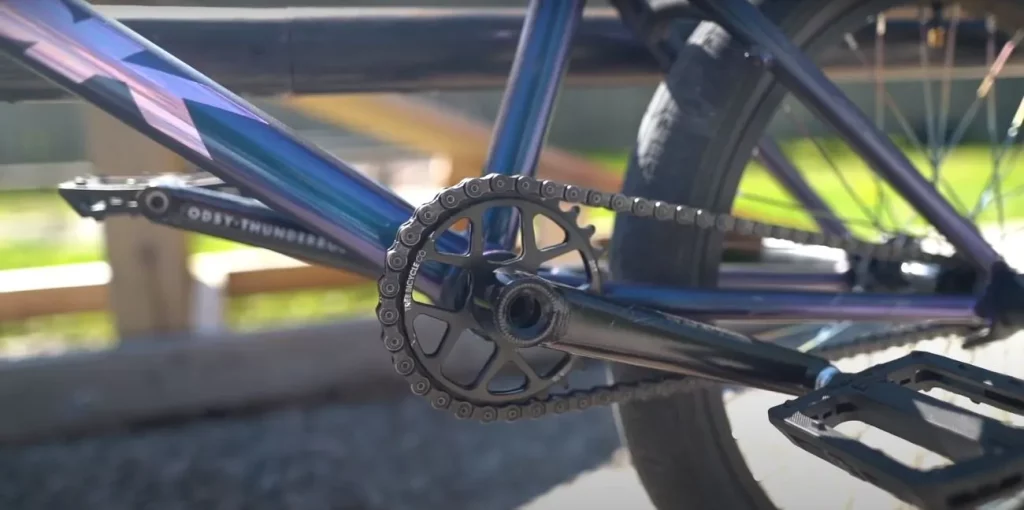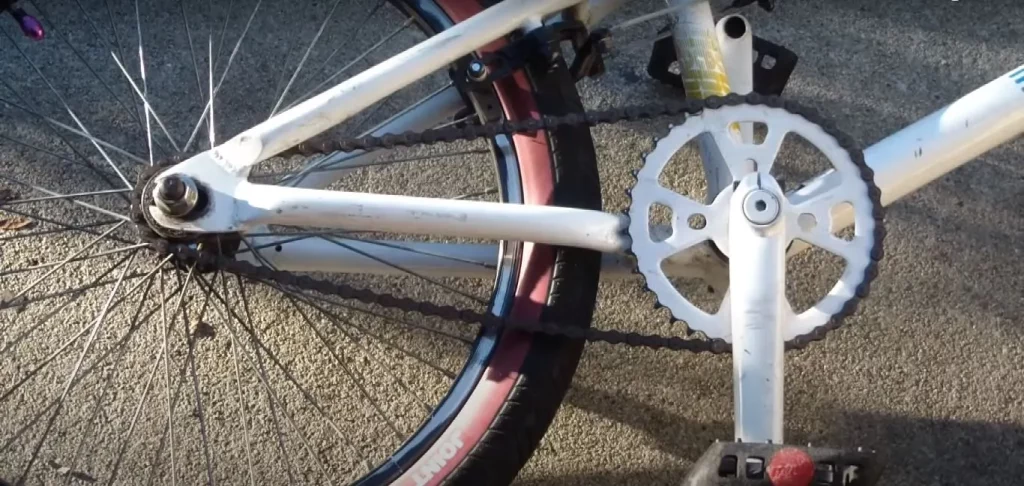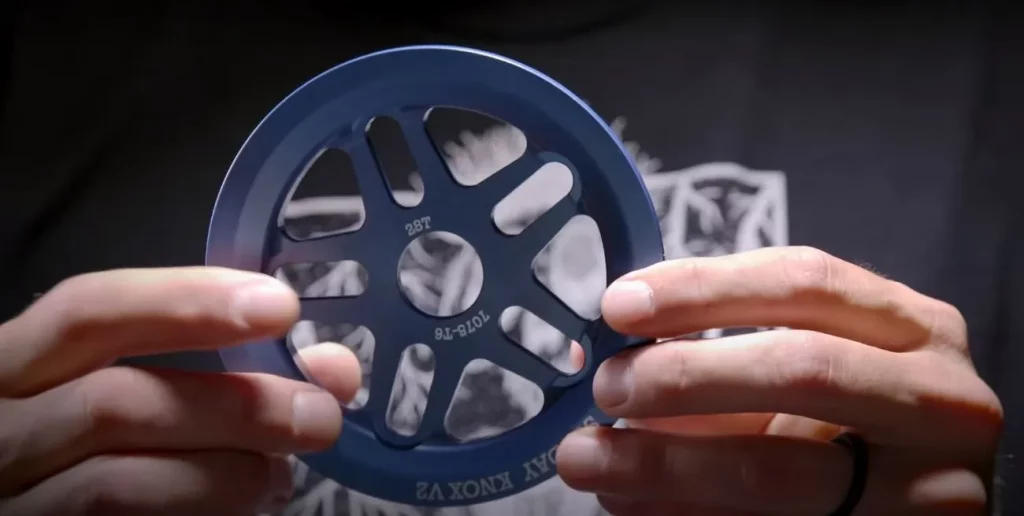Why Are BMX Bikes Equipped With Small Sprockets? Explained

The primary component of the bike’s propulsion system is its reliance on sprockets. The chains are mounted on the sprockets that are used to transmit the rotating movements to the rear tires. There are numerous different sizes and types of sprockets. A smaller sprocket is present on BMX bikes, as you will notice if you have ever used one.
Why Do BMX Bikes Have Small Sprockets
Newer acrobatic BMX bikes have a smaller primary sprocket for quicker acceleration and greater clearances from the frame to the floor. The likelihood of shin impacts is also minimized by the smaller sprocket
The ideal sprocket size is often determined by evaluating the bike’s intended to use against a workable gear ratio that is dependent on the dimensions of the rear cog attachment and the placement of the brake mounting.
But why is it the case? Is it feasible that the design was done on purpose? Are there any specific advantages associated with this little piece of equipment? We have conducted significant studies on this subject and will explain the advantages below.
Table of Contents
Why Do BMX Bikes Have Small Sprockets?

The BMX bikes stand out for a number of different reasons, such as the following, owing to their small sprockets:
- Assists With Riding
The ability to ride is greatly aided by smaller sprockets. The chain is reduced to the point where it comes in close interaction with the top of the braking. Due to this arrangement, you won’t need to put in much effort to ride the bike from one place to another. Of course, this results in less effort required from you.
- Higher Force is Produced.
Smaller sprockets do have a lower propensity to bend than their larger counterparts. As a consequence, they provide much more force since you need to spend less effort to use them. If you have to bike for an extended amount of time or handle severe slopes, you will find this to be fantastic.
- It Has A Longer Lifespan.
A typical riding trail has a lot of things that need to be dodged and negotiated. The result of these barriers is that they cause significant damage and decrease the entire lifespans of the bikes. Once more, it has been found that smaller sprockets are more durable.
- Provides a More Significant Amount of Touch Surface
You must make greater touch with the surface if you want to ride your bike efficiently. As opposed to their bulk rivals, smaller sprockets have indeed been discovered to create more contact surfaces. By extension, this increases the ease and enjoyment of the riding process.
- Overcomes Challenges With Ease
According to research, smaller sprockets are considered to provide a benefit in overcoming the barriers. It is much simpler to prevent them from interfering with any static things that might reside along the bike’s course. This quality will be essential if you plan to pull off any stunts.
- More Maneuverable And Lighter in Weight
The tiny sprockets are also more portable and malleable than their bigger counterparts. They don’t put you under an excessive degree of strain or burden. Because of this, you may discover that they function well for extended bike rides and traversing rugged terrain.
- Suitable For off-road Situations
Again, the smaller sprockets are what you ought to concentrate on if your hunt for the ideal bike is motivated purely by the necessity to withstand off-road environments. They have a reputation for being quick and utterly competent at managing off-road situations.
- More Gentle With Your Lower Muscles And Legs
It shouldn’t be surprising that you will use a bunch of lower body muscles when biking. Yet, steering using the smaller sprockets requires less effort and muscular strength than with the larger ones. Or, to put it another way, smaller sprockets are gentler on your thighs and bottom muscles.
- Speedier And Faster
When all things are equal, the smaller sprockets surpass their larger counterparts when it comes to acceleration and rate of speed. This indicates that they will get you to the destination more quickly. Why wait longer to accumulate something or accomplish something like that when you can do it more speedily?
- For Racing, Small Sprockets Work Well.
These sprockets are especially ideal for racing due to just how light and elegant they are. In addition to delivering smoother rides overall, they hardly ever impede your motions. In particular, they handle challenging and meandering territories with exceptional ease. Do we really need to explain that they enable prolonged utilization?
- Smoother And More Nimble
Despite the fact that you will have to use some energy to drive the little sprocket, you will typically need less effort due to it being smoother and more flexible. Less pressure on the bike chains and more enjoyable experiences for everyone are positives of this system.
- Less Torque is Required When Turning
You will undoubtedly have to apply some torque to your bike in order to propel it around and around a sharp bend. Nonetheless, the torque’s strength largely depends on whether a smaller or larger sprocket is connected. The majority of the time, you use less of it, which relieves your body of the anxiety that comes along with it.
The Benefits of Smaller Sprockets

- Clearance
Bike throws and accidents with ledges, rails, and other obstructions are typical in freestyle BMX riding. As a consequence, there is a strong probability that a bike part will be damaged when doing the trick or moving.
The frame of the BMX bike has more clearance from the surrounding while the front ring and back sprocket is smaller and sleeker. Hence, there’s a lower chance that the bike may “hang” on something.
- Less Shin Hits Are More Likely
The probability of being struck in the shins increases with bigger chainrings. You can sustain an unattractive scar on your shins from specific strikes, which is additionally very unpleasant.
- Strength
The lower radius of a smaller sprocket allows it to be harder to bend because less force can be transferred to the chainring by leverage. Smaller sprockets are more brutal and can resist more force of impact without significant degradation, provided other variables (material, build quality, etc.) are adequate.
- Lighter
Because each component of the drivetrain takes less material to be manufactured, a drivetrain with a smaller chainring and back cog is lightweight. The bike’s decreased weight is partially the consequence of the small chainring’s necessity for a short chain.
Given the inherent strength of the majority of BMX bikes, weight is not a significant consideration. But a small drivetrain will definitely be advantageous if the intention is to create the lightest setup imaginable.
- More Easily Accelerating
Making it more straightforward to speed at the cost of top speed, the user decreases the gearing by employing a smaller chainring. The small cog improves the gearing once more when the rear cog is similarly switched out for a smaller one.
Hence this doesn’t have any influence. It is not essential for freestyle BMX bikes to have a high top speed since they are not employed for racing. Also, the majority of locations provide little or no margin for acceleration. A smaller sprocket could prove more advantageous in that condition.
- Joint Tension is Reduced
Because the drivetrain can be moved with less effort when using low gears, the joints are not as strained. The bike will have reduced gearing as well as be joist-friendly if a tiny sprocket is fitted while keeping the same back cog.
The Drawbacks of Smaller Sprockets

- Wear And Tear of Chains
Because there are fewer links in the chain in interaction with the bike chainring and back cog, smaller drivetrains impose an added burden on the chain. As a consequence, the region encompasses higher stress, and the connections disintegrate more quickly.
- Wear And Tear of Sprockets.
The tension from the chain is dispersed over lesser teeth in smaller sprockets, which leads to a shorter life expectancy. The teeth consequently become thinner more rapidly.
- A Lower Top Speed
The maximum speed that the bike is competent of will reduce when the front ring is reduced, whereas the back cog is maintained.
Cleaning and Basic Sprocket Maintenance
- Proper cleaning
You must take care of a sprocket if you intend for it to serve you for an extended period of time. A more lasting sprocket can be obtained by first cleaning. Degreaser must be sprayed onto the cassettes (sprocket) with a spray bottle or brushes on a constant schedule. When you apply it, you ought to allow the degreaser to drip from the sprocket.
Your primary cleaning equipment should be a brush with firm bristles, and cleaning in between each sprocket should be accomplished with a cloth. Before you begin cleaning the sprocket on your BMX, you might want to grab some WD40 to remove any dirt particles from the cassette.
- Lubrication
The sprocket needs to have a little lubrication on it every time WD40 is sprayed, or it is wiped. Each chain roller needs to have a drop of lube added to it in order to lube the sprocket. After that, you must spin the wheels in the opposite way now for about 20 seconds in order to allow the lubrication time to spread throughout and enter the chain roller.
Always begin applying lubricant at the connecting pin, so you are informed of where you started in order to improve the effectiveness of the lubrication procedure. Moreover, using too much lubrication is not an intelligent option.
FAQs:
Which sprocket is preferable for BMX: bigger or smaller?
Gear ratio is a decision that is personal, just like many other elements of bike setup. A higher gear ratio will be achieved by decreasing the total number of teeth on the back sprocket or by increasing the number of teeth on the front sprocket.
This will make it difficult to ride the bike when it first gets off but will enable a faster actual performance.
What sprocket size is ideal for a BMX bike?
Given that it suits the majority of riding styles, the gear with a 25-tooth sprocket will be regarded as the most common gear ratio in BMX bikes.
Small enough to allow for clearance when grinding, even while maintaining a comfortable riding force. Also, practically all modern freestyle BMX bikes have this size gearing.
Is it more difficult to bike with a larger sprocket?
It is harder to ride on the smaller cogs and more straightforward on the larger cogs. The individual rings in the rear are known as cogs.
The stack of cogs on geared bikes can vary in numbers from five to twelve, and based on the type, it is known as a cassette or a freewheel. Nonetheless, cassettes have become the most commonly used type of cog on modern bikes.
What type of gearing is ideal for BMX?
The traditional BMX gearing has changed throughout time to be 44/16, which has around 55 gear inches. Most people seem to feel most comfortable with gear ratios that are relatively close to 55 inches, which is where the most common gear ratios are.
How come BMX bikes are so powerful?
Usually, steel is used to make the frames. Entry-level models are frequently made of heavier, less expensive high-tensile steel. In contrast, more expensive models are usually made of 4130 chromoly tubings, and some mid-range bikes combine the two materials. Although chromoly is more potent than steel, it is also a little bit lighter.
Conclusion:
Now you know why do BMX bikes have small sprockets. The smaller sprockets on BMX bikes generally have a significant positive effect on an individual’s body. The bike’s creators have achieved the foresight and insight that their adversaries lacked. You can choose a bike like this with the help of all these reasons, which are more than adequate.
